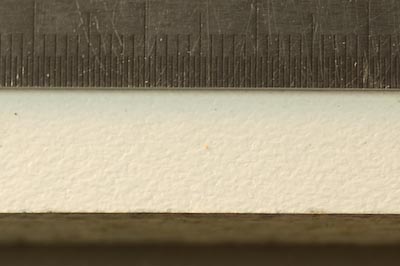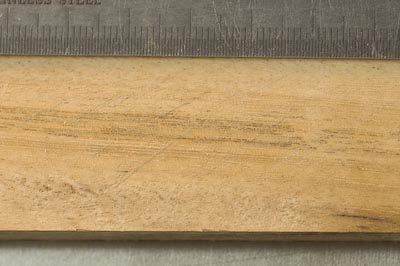
Intended purpose: Crosscut / Combination
Tooth count: 60
Price: $110
Source: Woodworking Warehouse
Tooth Grind: ATB (alternating top bevel)
Kerf: 3.20mm
Carbide thickness (measured front face to braze): 2.28mm
Carbide length: 6.67mm
Front face length: 4.3mm

Blade axial runout: 0.002″ (0.05mm)

Expansion slots: 4, curvy hook design with crack limiter.

There are also an extra set of 8 laser cut slots, 2 between each of the main expansion slots. I’m not sure if they are more part of the anti-noise than simply maintaining blade dimensional stability.

Anti-vibration slots: 4 x double lasercut
The anti-vibration features of this blade certainly do make a difference to the noise this blade generates, both during the cut, and when free-spinning. I find, if you listen closely to a non-noise dampened blade, you can hear quite a distinct ring emitting from the blade once the cut is completed. This blade does not exhibit any of that ringing, and subsequently does run quite a bit quieter, at least perceivably. The anti-vibration is also meant to give the blade tips an added lease on life.
Blade body thickness: 3.20mm for the inner portion of the blade, 2.20mm for the outer portion.
This is definitely an interesting feature of this blade, and although not unique, is still rather uncommon. The blade kerf is 3.2mm due to the width of the carbide tips, so it is not a thin-kerf blade, but it has a distinct advantage that the teeth are doing the cutting, and there is significant clearance for the body of the saw blade so it then doesn’t rub on the cut section. This makes for less friction (and heat) for cutting thinner materials, and yet for very thick materials when the blade is at full height, the centre of the blade is the width of the cut, the edge is still kept cooler as it is not rubbing. The design, combined with the anti-vibration slots mean the blade is self-stabilising, and so is claimed does not need the external stabilisers that some choose to use on their tablesaws. Personally, why not have both!! (Now I just need to source some!).
General Description:
This is a stunning blade, both in look and performance. It is has the latest coating developed by Freud called I.C.E. which has been specifically formulated for the professional market. To quote from their website:

“Silver I.C.E.™ (Industrial Cooling Element) Coating is a revolutionary coating that resists heat twice as long as standard polished blades. The shiny, mirror-like Silver I.C.E.™ Coating protects the blade from heat stress that can cause rapid loss of tension, which in turn causes blade warp, overheating, and poor cut quality. Additionally, the coating reduces the possibility for corrosion, resin, or pitch build-up, which further reduces the heat element responsible for drag on the motor.”
The blades are fully lasercut, tri-metal brazed (silver-copper-silver, which provides the tips slight flexibility reducing tip breakage) and have a pre-tensioned body from Rc46+ steel.

The cuts:
Melamine (Particle Board Backing)

Top Edge
An impressive cut, on both the top and bottom surfaces with this blade, with no tearout on either surface.

Bottom Edge
KD Hardwood Rip

This blade is not designed for ripping, so the rip cuts did have increased resistance (or turning that around, they required a slower feed rate), but even so, the results were pretty special. Only a few minor scratches (as can just be seen here) are apparent in the cut surface.
Treated Pine Rip

Again, very hard to see, there is the finest scratches on the surface only.
Softwood (Pine) Rip

There are simply no discernible marks in this surface. I haven’t experienced a Freud Glue-line blade, but I can’t see how the finish could be any better.
KD Hardwood Crosscut


Closeup of tearout on hardwood crosscut
The hardwood crosscut went very smoothly. The surface shows only the faintest surface marks (and I’m being pretty finicky in mentioning them!) There is no break-out at the end of the cut either – fibres are sliced as if with a razor.
Treated Pine Crosscut



Again, not much more can be added to what can be seen in these photos, even the closeup. The surface almost has a polished appearance.
Softwood (Pine) Crosscut


The pine crosscut again went very well, and only a small amount of break-out at the end of the cut.
Overall, this blade was pretty spectacular. I’d use it as a specialty blade, rather than just for any job just to keep it operating as well as it has here. If a cut needed a fine finish, rip or crosscut, or some melamine etc needed cutting, then this blade would be an excellent choice. If there was a lot of ripping to do, I’d probably go for a more dedicated rip blade, but accepting that the finish wouldn’t be as good as this blade could achieve.
I certainly would be interested in meeting the rip version of this blade – the two would be an awesome package.









[…] The next review from the “Battle of the Blades”. The Freud LU2B 0700 60 tooth crosscut blade […]
does freud or any other brand make a blade like the LU2B0700 that is brilliant for both cross cutting and ripping?
Well other than the Freud LU2B0700 😉 I have been hearing interesting things about Flai, and the Forrest Woodworker2 gets a great rap in the US.